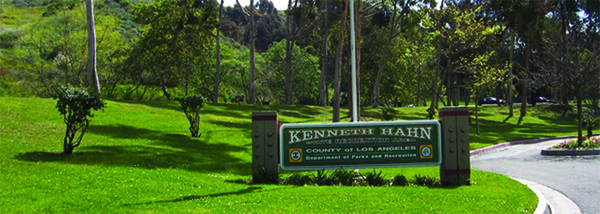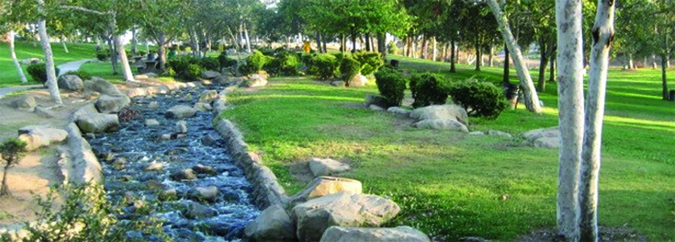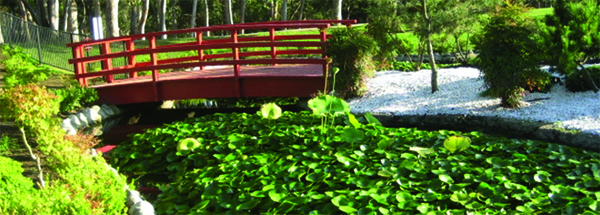Kenneth Hahn, Our Very Own Central Park
- Details
- Category: Community News
- Published on Tuesday, 15 December 2015 22:06
- Written by Dianne Lawrence
 Did you know that a 10 - 15 minute drive will bring you to one of our city’s largest parks? Often referred to as the Central Park of L.A.. Kenneth Hahn State Recreation Area, (entrance off La Cienaga just south of Rodeo), covers 338 acres and provides a large variety of landscapes from rugged hiking trails, to a peaceful koi pond with lotus blossoms and turtles, to an artificial waterfall with a beautiful view of the city, to a small river that empties into a larger fishing pond, stocked monthly and home to herons, ducks, geese and assorted other birds. The trails offer different levels of effort with helpful signs along the way alerting you to the benefits of your walk or information about what’s in front of you.
Did you know that a 10 - 15 minute drive will bring you to one of our city’s largest parks? Often referred to as the Central Park of L.A.. Kenneth Hahn State Recreation Area, (entrance off La Cienaga just south of Rodeo), covers 338 acres and provides a large variety of landscapes from rugged hiking trails, to a peaceful koi pond with lotus blossoms and turtles, to an artificial waterfall with a beautiful view of the city, to a small river that empties into a larger fishing pond, stocked monthly and home to herons, ducks, geese and assorted other birds. The trails offer different levels of effort with helpful signs along the way alerting you to the benefits of your walk or information about what’s in front of you.

At the top of the hills you will enjoy astonishing vistas from the Santa Monica Mountains to downtown LA and to the ocean. Festive family events dot the landscape on the weekends at over 100 picnic tables with grills and playgrounds close by. If you want to get your game on, there are baseball and soccer fields, a half basketball court and a sand volleyball court. You have to pay a $5 fee to get into the park on the weekends and holidays but it is free during the week. Walking your dog (on leash) just before sunset as the light filters through the trees and you head up to the top of a trail to watch the sun go down, is another great pleasure the park offers our community.
Park Hours: Sunrise to Sunset
Vehicle Entrance Fee:$6.00 for vehicles
$10.00 for limousines
$12.00 for buses
Fees apply to weekends and holidays ONLY.

Some history from Wikipedia:
The Baldwin Hills were part of the homeland of the Tongva people, inhabited by them for over 8,000 years. In the 19th century the area was part of the Spanish and Mexican Ranchos of California era, with the Rancho Rincon de los Bueyes and Rancho La Cienega o Paso de la Tijera in and around the present day park. As Los Angeles quickly grew during the 20th century, only the rugged terrain of this section of the Baldwin Hills protected it from being developed.
In 1932 the area east of the park was used as the site of the first Olympic Village ever built, for the 1932 Summer Olympics in the 10th Olympiad, which Los Angeles hosted. Los Angeles later hosted the 1984 Summer Olympics, drawing athletes from 140 nations. To serve as a continual reminder of the events, 140 trees have been planted together on the hills where the 1932 Olympics took place, with each tree representing a nation that took part in the 1984 Olympics.
Between 1947 and 1951 the Baldwin Hills Reservoir was built in the hills on the future park site. In 1963 the reservoir's dam collapsed disastrously, washing away residences in the canyon and flooding the landmark Baldwin Hills Village (now Village Green) at the hills' foot. The news coverage of the disaster was the first time aerial footage was televised live. The reservoir's empty bowl is still visible.
In the late 1940s the city transportation master plan included building a new north-south freeway, the aborted Laurel Canyon Freeway-SR-170, that would have bisected the Baldwin Hills and future park site where La Cienega Boulevard currently crosses the hills.
The park is named after Los Angeles County Board of Supervisors member Kenneth Hahn, also the father of former Los Angeles mayor James Hahn and former Los Angeles City Council member and current Congresswoman Janice Hahn. The Kenneth Hahn State Recreation Area first opened in 1983 as the Baldwin Hills State Recreational Area, and was later renamed in 1988 to honor Supervisor Hahn and his preservation efforts there. Also since its opening the park has been expanded, as some of the adjacent oil wells have 'dried up' and the oil field land cleaned up and acquired.
In 1977 Los Angeles County Supervisor Kenneth Hahn convinced Vice President Walter Mondale to reuse the land, from former oil-drilling sites, for a public open space park. At the time the area was also a very popular spot for the then new sport of motocross, locals calling it 'Motorcycle Hill'. Land was acquired for the park, and now includes land of the Ballona Creek watershed that is a wildlife corridor from the hills, through Culver City to the Ballona Wetlands. Humans can also traverse this on the Ballona Creek bicycle path.
